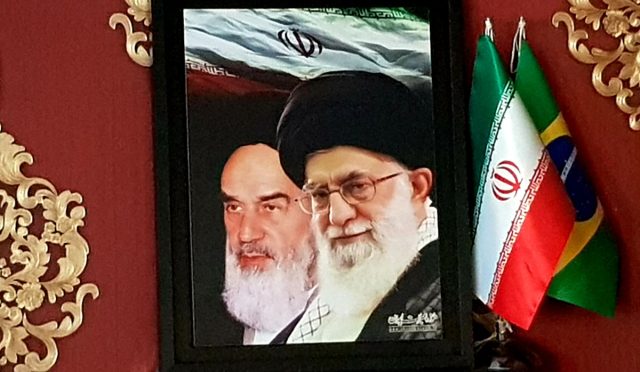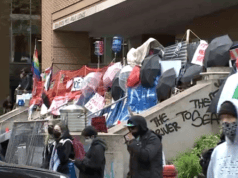By Rachel Avraham
From the 1979 Islamic revolution until today, the rule of the Ayatollahs in Iran has not stopped. Even in these days, when huge demonstrations are taking place in Iran against the theocratic rule, the Ayatollahs are still in power with their heads held high. Iran is an Islamic republic, where the clerics, the mullahs, have the upper hand and are the ones who ultimately approve the president’s actions.
The first Ayatollah to rule was Khomeini, who was an extreme Islamist who swept the masses of Shia Persians after him, even when he did not live in Iran, but in exile. He was followed by Ayatollah Khamenei, who is the spiritual leader of Iran to this day. Iran is a fairly important Middle Eastern power, with enormous geopolitical power, with other allies in the Middle East, with natural resources such as gas and oil, and influence over Shiite organizations/bodies throughout the world. The government in Iran, the rule of the Ayatollahs, the Mullahs, are reminiscent of another Middle Eastern empire, much earlier than Iran itself. The rule of the Ayatollahs is very similar to the rule of the pharaohs in Egypt.
First, the most obvious parallel between the Ayatollahs to the pharaohs is in their attitude toward the minorities living in Iran. In the book of Exodus, it is described how Pharaoh decided to kill all the firstborns of the people of Israel, who were a minority that began to grow within the Egyptians, out of fear that the Israelites would become an opposition within the Egyptians against his rule. In addition, the same fear motivated Pharaoh to enslave the Israelites and make them the slaves of the Egyptians.
Similarly, in Iran, under the rule of the Ayatollahs, the country’s minorities are treated as second class citizens by the government. In the province of Ahwaz in Iran (southwest of the country, adjacent to the Persian Gulf), there lived a Arab minority that had an independent rule for hundreds of years, but today it lives under oppression. The people of Ahwaz live in severe poverty, even though most of Iran’s natural resources come from that province. The Ahwaz strive for independence, but the Iranians are not ready to give up the golden eggs that the Ahwaz hen lays for them. Isn’t such conduct considered slavery? After all, if they were not Arabs but Persians, the people of Ahvaz would probably have received more rights over the natural resources found in their land (land which has been inhabited by them long before the Iranian government nationalized it). This is modern day slavery.
Following this, one can compare Pharaoh to Ayatollah in the sense of stubbornness. Pharaoh is described in the Bible as someone whose heart was hardened by God and therefore did not release the Israelites from slavery. The same is true of the Ayatollahs in Iran, in their stubbornness they do not release the many minorities who live in the country and wish to secede from Iran. Over the years, several demonstrations broke out against the regime in the Islamic Republic of Iran, some by Persians (who make up 50% of the population in Iran) and some by minorities. But it doesn’t matter who started each demonstration, but what these demonstrations were about.
In 2009, after Ahmadinejad’s overwhelming victory in the presidential elections, claims were made by the people that the election results were rigged. The reason this had widespread support for whomever ran against Mahmoud Ahmadinejad, former Prime Minister Mir-Hussein Mousavi, had so wide of margin that Ahmadinejad winning did not make sense. Then crowds came out to demonstrate against the election massacres. The Revolutionary Guards violently suppressed the demonstrations and Ahmadinejad remained the president.
In February 2011, Mousavi and his people tried to organize a protest against the Ayatollahs’ rule, inspired by the events of the Arab Spring, but the Iranian intelligence found out about it and arrested them. After that, riots began once again across the country against the authorities, one of the protesters’ chants was “Mubarak, Ben Ali, now it’s Ali’s turn”. These demonstrations were also forcibly suppressed by the regime. Both between 2017 and 2018 and between 2018 and 2019, there were a series of protests in Iran against the background of the terrible economic situation in the country and the governmental slaughter. Of course, these demonstrations were also suppressed by force and with multiple arrests.
The demonstrations of our day emphasize the minorities in Iran more than the Persians. The ones who started the protests were the Kurds, after Mehsa Amini, an Iranian citizen of Kurdish origin, was arrested for not complying with the rules of wearing the hijab and was murdered by the Iranian police. After the Kurds started the demonstrations, they spread to all the minorities in the country as well as all the citizens. Even after the Islamic Republic lost its legitimacy to rule the country, the Ayatollahs will not give up their place.
Another angle to this comparison is that just as the pharaohs did not agree to free the Israelites who would ascend to the land of Canaan and be freed from slavery in Egypt, the same is true in today’s Iran. The Revolutionary Guards forbid Jews to leave Iran and immigrate to Israel.
As I wrote at the beginning, pharaonic Egypt was a Middle Eastern power. Its territory at its height reached Sudan and southern Turkey. It had many natural resources and the government was very rich (but the inhabitants did not enjoy this wealth). So it is with the Islamic Republic of Iran. Iran is a Shia Middle Eastern power that competes with Saudi Arabia (just as in certain periods ancient Egypt competed with other Middle Eastern powers, such as the Babylonians or the Assyrians). Iran has many natural resources such as gas and oil and the country’s territory is huge. The governmental slaughter to stay in power causes wealth accumulation among the people in power, while the Iranian people themselves go hungry for bread. On top of that, the Egyptians were headed by a pharaoh, a one-man rule. The same is true in Iran, whose Supreme Leader is the Mullah, Ayatollah Ali Khamenei.
According to the comparison I made, I believe that today’s pharaohs are certainly the Mullahs and more specifically, they are the Ayatollahs who rule Iran today.
 Rachel Avraham is a political analyst working for the Safadi Center for International Diplomacy, Research, Public Relations and Human Rights, which is run by Mendi Safadi, a former Likud Candidate for the Knesset and a former chief of staff of former Israeli Communication Minister Ayoob Kara. Since 2012, she has been working as an Israel-based journalist and writer, covering Ayatollah,
Rachel Avraham is a political analyst working for the Safadi Center for International Diplomacy, Research, Public Relations and Human Rights, which is run by Mendi Safadi, a former Likud Candidate for the Knesset and a former chief of staff of former Israeli Communication Minister Ayoob Kara. Since 2012, she has been working as an Israel-based journalist and writer, covering Ayatollah,
Daily Wire, the Christian Post, the Baltimore Jewish Times, the Jerusalem Post, Israel Hayom, Ahval and many other publications across the globe. She received her MA in Middle Eastern Studies from Ben-Gurion University. She got her BA in Government and Politics with minors in Jewish Studies and Middle Eastern Studies from the University of Maryland at College Park.





